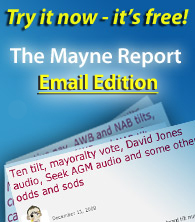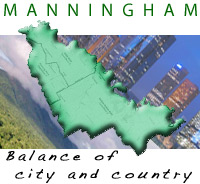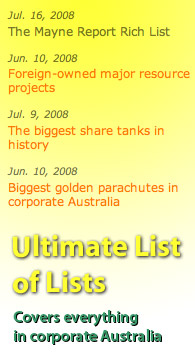Cossie's tax plan, Michael Egan, Rupert and Kerry Packer
July 16, 2008
Here are Stephen Mayne's five stories from the Crikey edition on Monday, 27 February, 2006.
5. Where did Cossie get this tax idea from?
By Stephen Mayne
This is probably a case of delusions of influence, but Peter Costello's international benchmarking exercise to determine which taxes will be cut in the May budget is precisely what I advocated in the opening half hour of the Economics working party at the Australian Future Directions Forum.
"If we're going to advocate any tax cuts, we should use international benchmarks as a guide and move on taxes where we're above average," was the tenor of the argument made in front of about 15 people, including newly installed Assistant Treasurer, Peter Dutton. Lo and behold, three weeks later and Dutton's immediate boss has decided to do exactly that.
Cossie's interview with Barrie Cassidy on Insiders yesterday included this line: "What I hope will occur is we can find out where Australia leads, and there are many areas where we lead, but we can also identify areas where Australia lags and they ought to become the priority as we improve our tax system."
Dutton probably didn't hear the comment, let alone mention it to Cossie, but when you sit in isolated splendour at home each day trying to influence public debate, a little bit of misguided gloating can keep your spirits high.
There was always going to be a bunfight in the AFDF Economics working party about tax and I used the benchmarking argument to launch a push for Australia to introduce a federal inheritance tax, seeing that the US and the UK have precisely that. The inheritance tax vote was eventually tied at 6-6 but stupid me wasn't there, having moved on to the Leadership and Governance working party by this time.
It will be interesting to see if this benchmarking study by Dick Warburton and Fightback! co-author Peter Hendy is confined to looking at existing taxes because inheritance and carbon taxes are common around the world but nowhere to be seen in Australia.
One thing's for sure, Cossie won't be copping any more whingeing from the business lobby about their 30% corporate rate, which leaves for dead those working stiffs on the top rate of 48.5%.
For mine, this looks like an exercise to finally cut the ridiculously savage top rate, something the Howard Government has failed to do in ten years. It was Paul Keating who cut John Howard's 60% top rate down to 48.5% and if Howard and Costello want a bit more respect from their core constituency, the top rate needs to begin with a three.
If looking for some guidance, perhaps the PM should dust off the small government tax policy he and Jim Carlton launched at the Box Hill Town Hall during the 1987 election campaign. I wagged school to attend that one and even got to shake "Little Johnny's" hand, but it certainly wasn't my idea to have that double counting blunder which cost him the election.
6. John Anderson joins an exclusive and forgetful club
By Stephen Mayne
Why is it that forgetfulness or oversight kicks in on some of the most sensitively timed share deals? Bluescope Steel CEO Kirby Adams took ten days to announce his controversial $9 million put options play last September and now John Anderson "forgot" to reveal he'd quit his AWB shares last October.
There are a few other interesting examples from the past. Steve Vizard disgraced himself by pocketing $1.1 million through the exercise and sale of his Multiemedia options in March 2000, yet despite being a director, he conveniently forgot to advise the ASX for almost six months and eventually made this embarrassing apology.
Jeff Kennett was also amazingly prescient in putting the share allocations that he personally lobbied for (Guangdong and Yates were the two that attracted controversy) into his wife's name, so they too weren't ever disclosed on his Parliament registry of interests.
The most outrageous example was former One.Tel director Steven Gilbert, an old associate of George Soros, who pocketed an estimated $90 million selling shares before the collapse but never told the ASX about any of it.
We now also know that Rene Rivkin and several dozen other Australians regularly traded ASX shares through Swiss bank accounts and, certainly in Rivkin's case, treated the disclosure laws with utter contempt.
So how does John Anderson dumping his AWB shares at $5 a pop on 5 October 2005, compare? Well, the Volcker report blew the whistle on AWB's disgraceful $290 million Saddam contribution just three weeks later on 27 October, prompting the PM to announce an inquiry on 30 October.
Peter Costello was strongly defending Anderson as an honourable man yesterday but it is certainly not a good look, although he announced his resignation as deputy PM and National Party leader on 23 June 2005.
I can well remember a conversation with an investment banker at the time the Farm Pride egg business in Victoria was floated on the ASX and he explained that Coalition governments often handed over these agriculture marketing bodies to farmer groups for free after pressure was applied through the National Party.
This got me thinking as to why the Howard Government gave away AWB in the only privatisation that didn't actually involve taxpayers receiving any money for the asset they were selling.
Now that Anderson has come clean with his handsome profit from the exercise, a more detailed explanation of the privatisation process is warranted. How many shares did he sell and how much did he specifically benefit from the policy to effectively gift the AWB to its grower customers? Was he involved in any lobbying to be extra generous to the farmers?
Glenn Milne ran the Labor line questioning the timing of Anderson's sale in The Sunday Telegraph yesterday but appeared to be backing away from it when, from the Insiders couch, he asked: "Mr Anderson, what's your message to the Labor Party for pursuing this? Is this fair politics or a sign that they have got nothing else to run with?"
Glenn, you're the bloke who wrote the story and of course it is a legitimate line of questioning. Dumping stock three weeks before a highly damaging report is released and then breaching the rules by not declaring it to parliament is a strong story no matter whether it's Graham Richardson or John Anderson.
11. Michael Egan's delusions of competence
By Stephen Mayne
Former NSW Treasurer Michael Egan has leapt into the trenches to defend his record in a strong opinion piece for The Sunday Telegraph. Sadly, it was full of the same old Carr-Egan bluff and bluster that sucked in the NSW media for a decade while, in the background, the state's finances were being recklessly managed.
Nowhere did Egan concede that he inherited a state with taxes close to the national average and departed with NSW comfortably leading as Australia's highest taxing state. And despite this revenue bonanza and an unprecedented property boom, NSW was facing a deficit of $533 million in 2006-07 without decisive corrective action, while all other states remained comfortably in surplus.
Then there is Egan's misleading ruse of ignoring all the debt he piled up in government business enterprises with his claim that:"We've now paid off around $10 billion of debt and our general government sector is virtually debt free."
Er, what about the NSW Government as a whole which has more than $20 billion of debt outstanding as you can see from this T-Corp press release in January last year gloating that debt is at a four-year high?
The most laughable Egan claim was that NSW has grown its net assets from $70 billion to more than $120 billion over the past ten years, making it "the highest net worth of any government – federal or state – in Australia".
Egan actually put the figure at $127.4 billion in this strategy document he released in December 2004, but I'll eat my hat if Queensland isn't worth more than NSW, because Queensland doesn't have $15 billion-plus in unfunded super and it has retained ownership of key assets such as ports, rail and airports.
Public sector accounting really is a joke in Australia, because the rules are so inconsistent. Egan's ridiculously inflated claim obviously includes every park and last piece of art owned by the state of NSW, whereas the Commonwealth budget confesses to a negative net worth of about $30 billion, so they're presumably not counting things like the $3 billion worth of art owned by the National Gallery.
I reckon BHP Billiton is easily Australia's richest institution with its $150 billion market capitalisation, although the majority of these assets are based overseas and owned by foreigners. The Catholic Church probably comes in second with more than $100 billion of Australian assets, although it is strictly controlled by the Vatican. Whilst these are guesstimates, the state of Queensland would be third with a net worth around the $90 billion mark, followed by NSW with about $70 billion.
The Feds are clearly hamstrung by the $90 billion unfunded superannuation liability and weakness in the Telstra share price, but they'll be back into positive territory for the first time since Whitlam by 2008-09, unless Howard and Costello decide to really crank up the tax cuts.
16. Why did Kerry Packer dump St Vincent's?
By Stephen Mayne
Kerry Packer's greatest benevolence almost certainly revolved around what he gave to Sydney hospitals and emails to Crikey continue to shed more light on what happened over the years.
Naturally, every time KP had an operation, he got a bill and the first time he had an operation at Royal Prince Alfred Hospital (RPAH), he said to the anaesthetist: "How much will this f*cking cost me?"
The anaesthetist, somewhat stunned, stammered "I charge the AMA rate", to which KP replied "I didn't mean your f*cking bill. Last time I had to pay the Sisters of Mercy $1 million."
Interestingly, Kerry Packer changed hospitals part way through his treatment for renal failure in around 1999. He had long been a St Vincent's patient, which is run by the Sisters of Mercy.
For the last seven years he went to RPAH and the exact reasons for the change are the subject of much rumour, but he was clearly unhappy. There's talk that the Sisters made an excessive grab for money or alternatively that KP was angry that St Vincent's had pushed aside Sister Bernice Elphick, a personal favourite of the Packer family as this SMH story explains.
Of course, KP may well have been telling the truth when he implied that he thought the RPAH nephrologists were better doctors.
KP is known to have funded the purchase of defibrillators for ambulances, famously, after his own cardiac arrest. He gave money to St Vincent's in the first half of the 1990s, and was patron of the Victor Chang Cardiac Research Institute.
He started giving significantly to the RPAH in the late 1990s and the "Kerry Packer Education Centre" at RPAH was completed in 2003-04. Similarly, he obviously donated to the "Kerry Packer Institute for Child Health Research" at the Children's Hospital at Westmead, which was completed in 2005.
An educated guess is that he would have put up about $10 million for each, but we're still a long way short of the Alan Jones claim that, when it comes to his Sydney hospital donations, "we're talking hundreds of millions".
It is also thought quite likely that he would have given a few bob to health services around Scone, as KP was something akin to a feudal lord in the upper Hunter Valley, but surely, if there really had been other significant contributions, we'd know by now.
As one cynical subscriber observed by email, "Rich robber barons have always bought immortality this way. He was no more venal, destructive, greedy, or arrogant than Carnegie, Mellon, or JP Morgan."
Keep the Packer stories coming to smayne@crikey.com.au.
17. Cult scandal hits Murdoch family church
By Stephen Mayne
Australia's two richest and most powerful families, the Murdochs and the Packers, aren't known for their religious observance, but what tenuous links they do have to the church are getting an interesting run in the press at the moment.
The Australian's John Lehmann has been running with the Packer connection to Sydney Anglican Archbishop Peter Jensen, pointing out that Jensen actually buried Australia's richest man at his Ellerston property on 30 December.
The Oz also ran with the Crikey tip that Packer had donated $1 million to the Anglicans, but this was denied as follows in today's paper:
The spokeswoman said it was "completely untrue" that Australia's richest man once donated about $1 million to Sydney's Moore Theological College, where Dr Jensen was a longtime principal.
While Kerry Packer famously told Parkinson that his family fortune started with his grandfather and "10 bob on a race course" in Tasmania, the Murdoch family fortune dates back 103 years when Rupert's dad, Sir Keith, was living with his parents in the manse of the Melbourne church which has been rocked by a cult scandal over the weekend.
Ronald Younger's authorised biography of Sir Keith includes the following:
When Keith was two years of age (in 1887), his father accepted the call from Trinity Presbyterian Church in Camberwell, six miles from Melbourne's heart, and the family moved to the manse attached to the church in Riversdale Road, which was to be the Murdochs' home during Keith's formative years.
The Herald Sun today followed up The Age's Saturday scoop, but both papers failed to point out the historical Murdoch family connection.
Reverend Patrick Murdoch wanted his son Keith to follow him into theological studies, but Keith decided journalism offered better prospects and in 1903, while still living in the Camberwell manse, he started out as The Age's correspondent for the neighbouring suburb of Malvern.
The Crikey bunker used to be based in Murdoch St, Camberwell, which we think was named after Camberwell's most famous family and we once almost rented a property a few doors down from the cult-ridden church near busy Burke Rd.
I well remember walking past the church one Sunday morning and spotting Bruce Teele amongst the congregation. Teele was the long-time chairman of JB Were which have been News Corp's primary broker in Australia for many years.
You couldn't help but wonder if attending the old Murdoch family church helped Bruce get the business and we certainly assume he is not one of the 15 elders tied up with this banned cult.
Copyright © 2024 The Mayne Report. All rights reserved






















